Biochar for Community Gardens
In July of this year Ian Kininmonth from the Transition Town Vincent (TTV) My Healthy Soils Project approached the North Perth Community Garden (NPCG) about biochar and the prospect of having a workshop demonstrating how to make and use biochar in the community garden. Like many community gardens, the NPCG already produced compost and worm castings/juice from other organic waste streams generated by the garden but had not found a way to deal with the woody biomass generated from their fruit tree’s prunings. Biochar represented a circular solution to helping them achieve their zero waste objectives and so they agreed to the opportunity. Fortuitously one of their members, Chris Watts, an Agricultural Science graduate from Curtin University was knowledgeable of the benefits of biochar and keen to help with the workshop and also join the My Healthy Soils Project team.
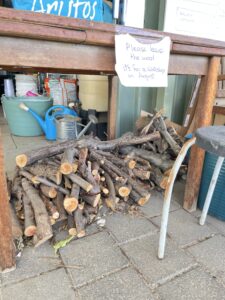
Dry fruit tree prunings (<20% moisture) were stored in a dry place ready for the workshop
The workshop was held on the 31st August with 15 attendees present, half from the NPCG. After the Chair of the NPCG, Emma Vosnacous, had introduced Ian and Chris the first thing to do was to provide some background to why we were here and to explain what biochar was and how it was produced. Fortunately people knew what charcoal was and it’s place in natural soils (as opposed to urban soils). Chris and Ian had also developed a comprehensive booklet: Biochar for Community Gardens covering much of what we were to talk about so that made things easier too. What people really wanted to see and hear though was the top-lit up-draft (TLUD) biochar oven (nicknamed Burny) doing its thing and the roar of the flames as it produced the biochar while they waited. What we didn’t want though was too much smoke and complaints from the neighbours.
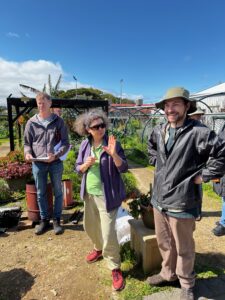
Emma introduces the presenters, Chris Watts and Ian Kininmonth
Kindling and leaves were placed carefully in the little, rusty TLUD on top of the one and a half foot long small branches which had been placed in earlier. Ian then nervously lit the leaves with a BBQ lighter and it gradually roared into life while generating some smoke as the oxygen in the air reacting with the carbon and other elements in the leaves to create the dark grey smoke of carbon monoxide and carbon dioxide. In previous charring’s this smoke had dissipated in a couple of minutes as the leaves and oxygen were burnt away and the heat started the pyrolysis process which in the oxygen limited environment meant that the methane and other gases escaping from the wood combusted while there was no oxygen to react with the carbon in the wood. True to script the TLUD generated no smoke after a couple of minutes and and after a few minutes more a temperature gun indicated that the oven was at the optimal temperature of 400-500 degrees Celsius. Phew!
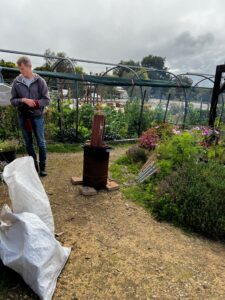
The TLUD soon fired into life and did its thing for an hour before being quenched.
As the audience watched the TLUD in operation, Chris and Ian talked more about biochar and some of its amazing qualities and its role in the soil. Two of the key qualities which the community gardeners were interested in included its water holding capacity and improvements in soil fertility. These were a couple of the reasons why it had initially been used in the TTV Britannia community food forest. Water holding capacity occurred because of two aspects. Firstly, by incorporating the biochar into the sand, it increased the distance between the sand particles and increased the porosity thereby enabling water to soak in. The second aspect was the porousness of the biochar molecules themselves which meant that with some biochar’s, a teaspoon worth had the surface area of a football playing surface. In some cases, such as with biochar produced from grass, the biochar could absorb 700 percent its mass in water! But how could you produce biochar from grass?
At this point Ian put some straw in a steel spice canister he had got from an Indian grocery store and dropped it into the TLUD. He also filled another canister with some of the pesky nuts of the Box trees which are common around the City of Vincent and another with the dried roots of couch grass and dropped them in too. Chris followed up with a demonstration of three funnels placed over jars: one containing sand, another compost and another with biochar and then ran equal volumes of water through them. The result was that the biochar held onto a little more of the water than the other two.
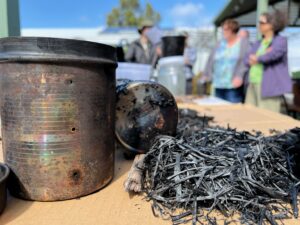
The steel canister method of charring was also demonstrated.
Increased fertility was another key characteristic that the community gardeners were very interested in. Quietly they were asking themselves “Can biochar help with my garden cred?” What they wanted secretly were bigger broccoli, enormous eggplants, colossal caulies, oodles of oranges, a plethora of passionfruit, lashings of limes and pray, the biggest pumpkin ever seen in the community garden! Well the research indicated that where biochar is combined with other organic or inorganic fertilisers then yields could increase an average of 48%. But the secret to achieving this was to inoculate or activate the biochar. So Ian and Chris explained the various methods for achieving this such as mixing it with compost or soaking in your favourite compost or worm tea and leaving for a couple of weeks before using it.
There was a lot of discussion about the other uses of charcoal too which helped the case for including it in the garden. For example, Emma works in the medical profession and was able to explain some of the ways it is used there, such as mitigating odours and removing toxins from wounds. Ian does a lot of hiking and he and his wife had a water filtration system which included a charcoal filter. Removal of nutrients, toxins and heavy metals from stormwater was another identified use it could be put to in the area, such as at the nearby Hyde Park lakes or the Smith’s lake. The ability of biochar to attract nutrients can be a good and bad thing. If you put biochar in the soil without inoculating or activating it, it can attract nutrients existing in the soil away from plants. Similarly if you apply chemical pesticides and herbicides it can affect their efficacy. Which can be a good thing if you want to remove certain contaminants.
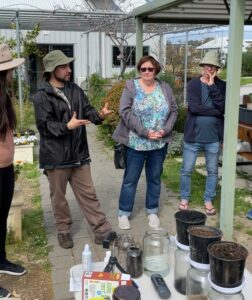
Chris discusses some of the features and benefits of biochar.
While Chris and Ian were talking the TLUD was quietly and smokelessly charring away at the optimum temperature of 350-500 degrees celsius. After over an hour the decision was made to quench the fire so as to preserve the charcoal. Leaving it to burn would have resulted in ash which, while also good for the soil, does not generate the same level of improvements and requires generating carbon monoxide and carbon dioxide, which the charring process aims to avoid. On a side but related note the point was made that biochar is a recognised negative emission technology (NET) by the International Panel on Climate Change (IPCC). As a consequence, one tonne of carbon in the form of biochar can be worth up to 3 times the value of carbon sequestered by other means e.g. trees. There is now a rapidly developing market for carbon credits generated by biochar. In fact some companies such as Microsoft and Shopify have negative zero targets (as opposed to net zero) and to achieve this buy biochar credits in market places such as Puro.earth.
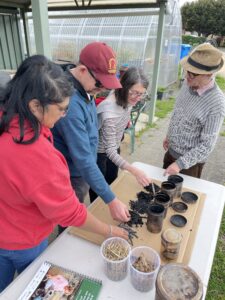
Participants get to see and feel the biochar and the biomass it is made from.
The quenching involved firstly hosing down the biochar in the TLUD biochar oven and then tipping it out onto a sheet of metal and quenching it further. The same applied to the steel canisters. The workshop participants then had the opportunity to feel and crack the now brittle biochar which just over an hour before was pruning’s sitting under the roof of the community garden’s shed. There was particular satisfaction in seeing that the the roots of the couch grass (aka the gardener’s curse) had also charred successfully along with a batch of Box tree nuts (aka the pedestrian’s curse).
The final discussion focused on methods for crushing biochar. A number of methods were discussed. The first was simply pulversing it with a bit of wood or hammer etc while it was still in the TLUD. The other involved getting a sack or cloth shopping bag and then running over it with a vehicle tyre. The final one involved using a blender. Ian had got a blender off the local Buy Nothing page (he wasn’t allowed to use the one at home ;-( ) and used that to create a powder. This creates its own problems as it shouldn’t be inhaled.
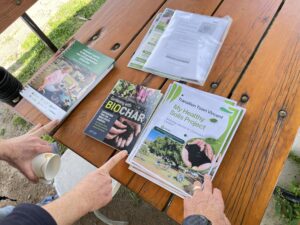
A handy booklet was specifically compiled for the workshop.
Finally, the question was raised “How do I get hold of some of the tools used” and “where do I get more information”. Our objective is to make them available through the tool n things library. This would include the steel canisters, the TLUD (60L and 160L versions), the heat proof gloves and the biochar blender. We are keen to hold other workshops with community gardens and other groups to empower people with knowledge about biochar and how to make it.
Overall the workshop achieved multiple objectives including providing the North Perth Community Garden with a circular way of dealing with their tree pruning’s, sharing knowledge about the features and benefits of biochar, how to use it in community gardens and different ways to make it in an urban environment. We hope to run more workshops next year with community gardens and Transition Town groups around Perth and Western Australia. Contact us below to discuss conducting a workshop with your group.
Useful resources:
- Workshop Booklet – Biochar for Community Gardens
- Video – Biochar for Community Gardens
- Guidelines for operating the top-lit updraft (TLUD) biochar oven
- Joseph, S. and Taylor, P. (2024) A farmers guide to the production, use and application of biochar. ANZBIG.
Contact:
Ian Kininmonth, Transition Town Vincent (TTV) email: ian.kininmonth@ttv.org.au or Mobile +61 0401 521 895.
